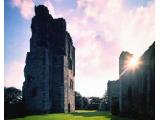Ashby-de-la-zouch Castle
| |||||||||||||||||||||
A visit to Ashby Castle makes a great family day out in Leicestershire. The property began as a manor house in the 12th century and reached castle status in the 15th century. Come and find out about the castle’s colourful history with our lively audio tour. Hear how Edward IV’s Chamberlain Lord Hastings added the chapel and the impressive keep-like Hastings Tower – a castle within a castle. Visitors can still climb the tower today despite it suffering massive damage during the Civil War. There are great views from the top! Then make sure you discover the underground passage from the kitchen to the tower, probably created during this war, which can still be explored today. Don't Miss Walk the underground passage between the tower and the kitchen Be amazed that you can still climb to the top of the half ruined tower Find out more about the castle's dramatic history in the company of our amusing audio guide Admission: Adult £5.30 Child (5 to 15 years) £3.20 Concessions £4.80 Family (2 adults, 3 children) £13.80 Opening Times: 10am to 6pm Wednesday through Sunday from March through September. October and November 10am to 5pm again Wednesday to Sunday. November to March weekends only 10am to 4pm. Ashby Castle forms the backdrop to the famous jousting scenes in Sir Walter Scott’s classic novel of 1819, Ivanhoe. Now a ruin, the castle began as a manor house in the 12th century. It only achieved castle status in the 15th century, by which time the hall and buttery had been enlarged, with a solar to the east and a large integral kitchen added to the west. Between 1474 and his execution by Richard III in 1483, Edward IV’s Chamberlain Lord Hastings added the chapel and the impressive keep-like Hastings Tower – a castle within a castle. Visitors can now climb the 24 metre (78 feet) tower, which offers fine views. Later the castle hosted many royal visitors, including Henry VII, Mary Queen of Scots, James I and Charles I. A Royalist stronghold during the Civil War, the castle finally fell to Parliament in 1646, and was then made unusable. An underground passage from the kitchen to the tower, probably created during this war, can still be explored today. In 2006 archaeologists investigated the mysterious castle garden, famous for its elaborately shaped sunken features. | |||||||||||||||||||||
